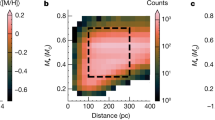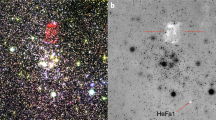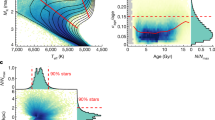Abstract
Planetary nebulae mark the end of the active life of 90% of all stars. They trace the transition from a red giant to a degenerate white dwarf. Stellar models1,2 predicted that only stars above approximately twice the solar mass could form a bright nebula. But the ubiquitous presence of bright planetary nebulae in old stellar populations, such as elliptical galaxies, contradicts this: such high-mass stars are not present in old systems. The planetary nebula luminosity function, and especially its bright cut-off, is almost invariant between young spiral galaxies, with high-mass stars, and old elliptical galaxies, with only low-mass stars. Here, we show that new evolutionary tracks of low-mass stars are capable of explaining in a simple manner this decades-old mystery. The agreement between the observed luminosity function and computed stellar evolution validates the latest theoretical modelling. With these models, the planetary nebula luminosity function provides a powerful diagnostic to derive star formation histories of intermediate-age stars. The new models predict that the Sun at the end of its life will also form a planetary nebula, but it will be faint.
This is a preview of subscription content, access via your institution
Access options
Access Nature and 54 other Nature Portfolio journals
Get Nature+, our best-value online-access subscription
$29.99 / 30 days
cancel any time
Subscribe to this journal
Receive 12 digital issues and online access to articles
$119.00 per year
only $9.92 per issue
Buy this article
- Purchase on Springer Link
- Instant access to full article PDF
Prices may be subject to local taxes which are calculated during checkout



Similar content being viewed by others
References
Vassiliadis, E. & Wood, P. R. Post-asymptotic giant branch evolution of low- to intermediate-mass stars. Astrophys. J. Suppl. Ser. 92, 125–144 (1994).
Bloecker, T. Stellar evolution of low- and intermediate-mass stars. II. Post-AGB evolution. Astron. Astrophys. 299, 755–769 (1995).
Jacob, R., Schönberner, D. & Steffen, M. The evolution of planetary nebulae. VIII. True expansion rates and visibility times. Astron. Astrophys. 558, A78 (2013).
Jacoby, G. H., Ciardullo, R. & Ford, H. C. Planetary nebulae as distance indicators. Publ. Astron. Soc. Pac. 4, 42–56 (1988).
Ciardullo, R. The planetary nebula luminosity function at the dawn of Gaia. Astrophys. Space Sci. 341, 151–161 (2012).
Ciardullo, R. The planetary nebula luminosity function and its issues. Proc. IAU 29B, 15–19 (2016).
Jacoby, G. H. The luminosity function for planetary nebulae and the number of planetary nebulae in local group galaxies. Astrophys. J. Suppl. Ser. 42, 1–18 (1980).
Allen, C. W. Astrophysical Quantities 3rd edn (ed. Cox, A. N.) (Athlone, London, 1973).
Mendez, R. H. & Soffner, T. Improved simulations of the planetary nebula luminosity function. Astron. Astrophys. 321, 898–906 (1997).
Méndez, R. H., Teodorescu, A. M., Schönberner, D., Jacob, R. & Steffen, M. Toward better simulations of planetary nebulae luminosity functions. Astrophys. J. 681, 325–332 (2008).
Marigo, P., Girardi, L., Weiss, A., Groenewegen, M. A. T. & Chiosi, C. Evolution of planetary nebulae. II. Population effects on the bright cut-off of the PNLF. Astron. Astrophys. 423, 995–1015 (2004).
Schönberner, D., Jacob, R., Steffen, M. & Sandin, C. The evolution of planetary nebulae. IV. On the physics of the luminosity function. Astron. Astrophys. 473, 467–484 (2007).
Gesicki, K., Zijlstra, A. A., Hajduk, M. & Szyszka, C. Accelerated post-AGB evolution, initial-final mass relations, and the star-formation history of the Galactic bulge. Astron. Astrophys. 566, A48 (2014).
Miller Bertolami, M. M. New models for the evolution of post-asymptotic giant branch stars and central stars of planetary nebulae. Astron. Astrophys. 588, A25 (2016).
Gesicki, K., Acker, A. & Szczerba, R. Modelling the structure of selected planetary nebulae. Astron. Astrophys. 309, 907–916 (1996).
Heavens, A., Panter, B., Jimenez, R. & Dunlop, J. The star-formation history of the Universe from the stellar populations of nearby galaxies. Nature 428, 625–627 (2004).
McDermid, R. M. et al. The ATLAS3D Project — XXX. Star formation histories and stellar population scaling relations of early-type galaxies. Mon. Not. R. Astron. Soc. 448, 3484–3513 (2015).
Richer, M. G., McCall, M. L. & Arimoto, N. Theoretical models of the planetary nebula populations in galaxies: the ISM oxygen abundance when star formation stops. Astron. Astrophys. Suppl. Ser. 122, 215–233 (1997).
Gesicki, K., Zijlstra, A. A. & Morisset, C. 3D pyCloudy modelling of bipolar planetary nebulae: evidence for fast fading of the lobes. Astron. Astrophys. 585, A69 (2016).
Miller Bertolami, M. M. & Althaus, L. G. Full evolutionary models for PG 1159 stars. Implications for the helium-rich O(He) stars. Astron. Astrophys. 454, 845–854 (2006).
Renedo, I. et al. New cooling sequences for old white dwarfs. Astrophys. J. 717, 183–195 (2010).
Althaus, L. G., Miller Bertolami, M. M. & Córsico, A. H. New evolutionary sequences for extremely low-mass white dwarfs. Homogeneous mass and age determinations and asteroseismic prospects. Astron. Astrophys. 557, A19 (2013).
Iglesias, C. A. & Rogers, F. J. Updated opal opacities. Astrophys. J. 464, 943–953 (1996).
Cassisi, S., Potekhin, A. Y., Pietrinferni, A., Catelan, M. & Salaris, M. Updated electron-conduction opacities: the impact on low-mass stellar models. Astrophys. J. 661, 1094–1104 (2007).
Weiss, A. & Ferguson, J. W. New asymptotic giant branch models for a range of metallicities. Astron. Astrophys. 508, 1343–1358 (2009).
Ferland, G. J. et al. The 2013 release of Cloudy. Rev. Mex. Astron. Astr. 49, 137–163 (2013).
Schönberner, D., Jacob, R., Sandin, C. & Steffen, M. The evolution of planetary nebulae. VII. Modelling planetary nebulae of distant stellar systems. Astron. Astrophys. 523, A86 (2010).
Frew, D. J. & Parker, Q. A. Planetary nebulae: observational properties, mimics and diagnostics. Publ. Astron. Soc. Aust. 27, 129–148 (2010).
Ciardullo, R., Jacoby, G. H., Ford, H. C. & Neill, J. D. Planetary nebulae as standard candles. II—The calibration in M31 and its companions. Astrophys. J. 339, 53–69 (1989).
Acknowledgements
A.A.Z. and K.G. acknowledge the financial support by The University of Manchester and by Nicolaus Copernicus University. A.A.Z. is supported by the UK Science and Technology Facility Council (STFC) under grant ST/P000649/1. M.M.M.B. is partially suported by ANPCyT and CONICET through grants PICT-2 014-2708 and PIP 112-200801-00940 and also by a Return Fellowship from the Alexander von Humboldt Foundation.
Author information
Authors and Affiliations
Contributions
A.A.Z. and K.G. developed the concept. M.M.M.B. provided the post-AGB evolutionary sequences obtained with LPCODE and computed the supplementary data. K.G. adopted the Torun codes for the present work, performed the photoionization calculations and synthesized the PNLF. All authors participated in discussions of the results, in their presentations in figures and descriptions in manuscript and in pinpointing the conclusions.
Corresponding author
Ethics declarations
Competing interests
The authors declare no competing interests.
Additional information
Publisher’s note: Springer Nature remains neutral with regard to jurisdictional claims in published maps and institutional affiliations.
Supplementary information
Supplementary Information
Supplementary Figure 1, Supplementary Text, Supplementary References
Rights and permissions
About this article
Cite this article
Gesicki, K., Zijlstra, A.A. & Miller Bertolami, M.M. The mysterious age invariance of the planetary nebula luminosity function bright cut-off. Nat Astron 2, 580–584 (2018). https://doi.org/10.1038/s41550-018-0453-9
Received:
Accepted:
Published:
Issue Date:
DOI: https://doi.org/10.1038/s41550-018-0453-9
This article is cited by
-
Solar structure and evolution
Living Reviews in Solar Physics (2021)
-
Asteroseismic signatures of the helium core flash
Nature Astronomy (2019)
-
The inside-out planetary nebula around a born-again star
Nature Astronomy (2018)



